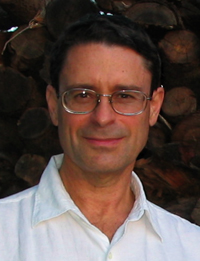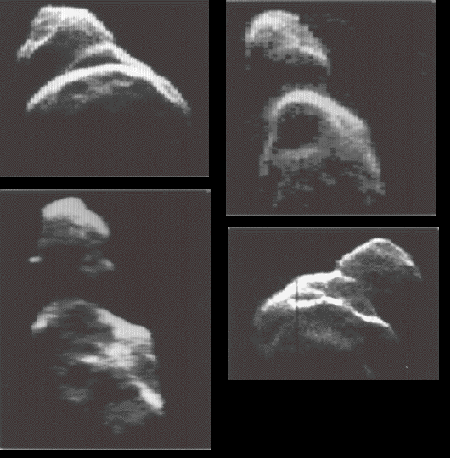By Larry Klaes
It was while I was working on our recent story on Near Earth Objects that Larry Klaes’ obituary for Steve Ostro arrived, a serendipitous event given Ostro’s landmark work in identifying planetoids and especially those that come perilously close to us. Ostro’s death last December came at a time of increasing public understanding of the threat posed by these objects. Yet the JPL radar astronomer, who used Arecibo’s facilities to such good effect, worked with tools that are now in danger of losing their funding, a commentary on how flexible our priorities can be even on issues of planetary survival. Ostro’s voice in Arecibo’s defense will be deeply missed.
Steven J. Ostro, a major player in radar astronomy who was both an alumnus and teacher at Cornell University, passed away on December 15 from pneumonia brought on by a long bout with cancer. He was 62 years old.
Ostro received his Master’s Degree in engineering physics from Cornell in 1974. Ostro then went to the Massachusetts Institute of Technology (MIT), where he graduated in 1978 with a Ph.D. in planetary science. While at MIT, Ostro used the Cornell-run Arecibo Observatory’s giant radio telescope on the island of Puerto Rico to bounce radar beams off the rings of the planet Saturn and the four large Galilean moons of Jupiter to study their properties.

Arecibo would become an important astronomical tool for Ostro in his ground-based exploration of the Solar System as his science career advanced. In 2003, Ostro was a member of the team led by Cornell astronomer Donald Campbell that utilized Arecibo’s powerful radar capabilities to study the surface of Titan, the largest moon of Saturn. Perpetually shrouded in thick orange clouds of nitrogen and methane, the distant moon’s surface is most effectively examined by radar. The 2003 radar exploration of Titan provided some of the first scientific evidence for hydrocarbon lakes there.
After completing his postdoc at MIT, Ostro returned to Cornell at the personal invitation of Cornell astronomer and science popularizer Carl Sagan to become an assistant professor of astronomy at the university. In 1984, Ostro moved to Pasadena, California to head the Jet Propulsion Laboratory (JPL) Asteroid Radar group. He also became a member of the Cassini-Huygens radar team studying the varied moons of Saturn in conjunction with the robot probe that has been orbiting the ringed planet since 2004.
At JPL, Ostro focused much of his scientific career on the study of planetoids using the radar facilities at Arecibo. The data returned from the radar beams bounced off those celestial chunks of rock changed humanity’s previous understanding of the vast numbers of relatively small objects that exist throughout our star system. Many of these objects exist due to the gravitational influence of Jupiter, whose great mass kept them from forming into large planets during the early days of the Solar System’s formation.
Through May of 2008, Ostro and his colleagues discovered 340 planetoids. Of this collection, the scientists confirmed that some of these minor bodies contained minerals such as nickel-iron and platinum in large amounts. They also provided the first radar images of planetoids, including objects known as contact binaries where two planetoids are in physical contact with each other. In early February of 2008, Ostro helped to find the first triple planetoid system that passes near our planet.

Image: These are radar images of asteroid 4179 Toutatis made during the object’s close approach to Earth on December 8, 1992. The work was carried out at the Goldstone Deep Space Communications Complex by a team led by Steven Ostro of JPL. The images reveal two irregularly shaped, cratered objects about 4 and 2.5 kilometers (2.5 and 1.6 miles) in average diameter which are probably in contact with each other. The four frames shown here (from left to right) were obtained on Dec. 8, 9, 10 and 13 when Toutatis was an average of about 4 million kilometers (2.5 million miles) from Earth. The large crater shown in the Dec. 9 image (upper right) is about 700 meters (2,300 feet) in diameter. Credit: Steve Ostro/JPL.
Ostro’s radar studies of planetoids, especially the ones known as Near Earth Objects, or NEOs, have done much to assist science both in understanding the nature and composition of these bodies and in gaining a wider appreciation of the potential threat they pose to our world. It is now recognized that some of these NEOs could one day impact Earth and wipe out most of the life on this planet, as likely happened with the dinosaurs 65 million years ago and in several other epochs.
To cite just two examples, Ostro and his team observed a half-mile wide planetoid named 1950 DA which they discovered has the highest known potential of any such celestial body to strike Earth, although not until the year 2880. If 1950 DA is not deflected or destroyed in the intervening centuries, its possible impact on our globe could cause major damage to the biosphere and disrupt human civilization.
The other potentially deadly planetoid is named 99942 Apophis, the Greek designation of the ancient snakelike Egyptian deity Apep, who constantly tried to destroy the creator god Ra. Ostro’s radar studies determined that initial concerns over Apophis striking Earth in 2029 and especially 2036 were overblown, but the planetoid, which is roughly the width of the Arecibo radio telescope, has warranted further study due to continued uncertainties in its orbit about the Sun. Former Apollo 9 astronaut Rusty Schweickart, who is now chairman of the B612 Foundation, a private organization dedicated to protecting Earth from space impacts, has suggested that a transponder be planted on Apophis to allow better tracking of that alien rock in the future.
In 1994, Ostro collaborated with Carl Sagan just two years before the latter’s untimely death on the potential consequences of celestial object impacts in a paper titled “Cosmic Collisions and the Longevity of Non-Spacefaring Galactic Civilizations.” In this paper, Sagan argued that species which do not eventually start colonizing other worlds run the risk of extinction due to a major impact event on their home planet. Ostro noted that while preventing a deadly strike by a planetoid or comet is an important task, the technology required to deflect a space object away from Earth could also be used by certain groups to deflect the same object towards our planet. Nevertheless, the authors voiced support for the continued radar studies of planetoids with Arecibo for both scientific and protection purposes. The paper may be read online.
Appropriately enough, a planetoid was named after Steve Ostro in honor of his important work with what astronomers used to call the “vermin of the Solar System.” Designated 3169 Ostro, this small and faint object orbiting the Sun between the celestial paths of Mars and Jupiter was found by Edward Bowell of Flagstaff, Arizona in June of 1981. Bowell also discovered another Main Belt planetoid which later bore the name 2709 Sagan, after the man who invited Ostro to join the Cornell faculty.


Space Weather News for Jan. 25, 2009
http://spaceweather.com
CURIOUS ASTEROID FLYBY: Newly-discovered asteroid 2009 BD is slowly passing by Earth today only 400,000 miles away. The approximately 10 meter-wide space rock poses no significant threat, but it merits attention anyway: The orbit of 2009 BD appears to be almost identical to the orbit of Earth. 2009 BD may be a rare “co-orbital asteroid,” circling the sun in near-tandem with our planet.
If current measurements of the asteroid’s orbit are correct, 2009 BD will remain in Earth’s neighborhood for many months and possibly years to come.
Visit http://spaceweather.com to view the asteroid’s curious orbit.
Eleanor “Glo” Helin Remembrance
Eleanor “Glo” Helin passed away in late January. She was one of the pioneers of the search for Near Earth objects (NEOs) and established and led the NEAT Project at JPL.
The NEAT Program discovered hundreds of NEOs, many comets, and 64 Potentially Hazardous Asteroids (PHAs).
Glo is survived by her son. If you would like to send him a note or card, his address is: Bruce Helin, 210 E. Elm St., Flagstaff, AZ 86001.
More information here:
http://planetarydefense.blogspot.com/2009/02/eleanor-glo-helin-remembrance.html
Long term impact risk for (101955) 1999 RQ36
Authors: Andrea Milani, Steven R. Chesley, Maria Eugenia Sansaturio, Fabrizio Bernardi, Giovanni B. Valsecchi, Oscar Arratia
(Submitted on 23 Jan 2009)
Abstract: The potentially hazardous asteroid (101955) 1999 RQ36 has the possibility of collision with the Earth in the latter half of the 22nd century, well beyond the traditional 100-year time horizon for routine impact monitoring.
The probabilities accumulate to a total impact probability of approximately 10E-3, with a pair of closely related routes to impact in 2182 comprising more than half of the total.
The analysis of impact possibilities so far in the future is strongly dependent on the action of the Yarkovsky effect, which raises new challenges in the careful assessment of longer term impact hazards.
Even for asteroids with very precisely determined orbits, a future close approach to Earth can scatter the possible trajectories to the point that the problem becomes like that of a newly discovered asteroid with a weakly determined orbit. If the scattering takes place late enough so that the target plane uncertainty is dominated by Yarkovsky accelerations then the thermal properties of the asteroid,which are typically unknown, play a major role in the impact assessment.
In contrast, if the strong planetary interaction takes place sooner, while the Yarkovsky dispersion is still relatively small compared to that derived from the measurements, then precise modeling of the nongravitational acceleration may be unnecessary.
Subjects: Earth and Planetary Astrophysics (astro-ph.EP)
Cite as: arXiv:0901.3631v1 [astro-ph.EP]
Submission history
From: Fabrizio Bernardi [view email]
[v1] Fri, 23 Jan 2009 10:03:29 GMT (139kb)
http://arxiv.org/abs/0901.3631
March 17, 2009
Newly Discovered Asteroid 2009 FH to Buzz Past the Earth Tonight
Written by Ian O’Neill
Another asteroid is set to make a close approach of 79,000 km according to NASA, a distance twice that of geosynchronous orbit around the Earth.
Although the 15-20 metre-wide rock is not expected to cause any problems to Earth or satellites, some observers may be lucky to spot the faint light from 2009 FH as it passes.
Interestingly, this new object comes only two weeks after a larger (50 metre wide) asteroid was spotted passing the Earth at a similar distance. So it begs the question, why are we seeing so many asteroids lately?
“This asteroid flyby will be a good viewing opportunity for both professional and amateur astronomers,” said Don Yeomans from the Near-Earth Object Office at NASA’s Jet Propulsion Laboratory in Pasadena, California. “The asteroid poses no risk of impact to Earth now or for the foreseeable future.”
NASA is always very quick to point out these objects are harmless, passing the Earth at a very safe distance, often beyond the Moon’s orbit. However, 2009 FH will pass at a similar distance to the 50 metre-wide 2009 DD45 on March 2nd.
Full article here:
http://www.universetoday.com/2009/03/17/newly-discovered-asteroid-2009-fh-to-buzz-past-the-earth-tonight/